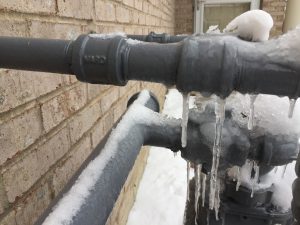Important Tips for Preventing Frozen Plumbing in Winter Conditions
Important Tips for Preventing Frozen Plumbing in Winter Conditions
Blog Article
The writer is making several good points relating to How to Prevent Your Pipes From Freezing in general in the article down the page.

Cold weather can damage your plumbing, particularly by freezing pipelines. Here's exactly how to stop it from happening and what to do if it does.
Introduction
As temperature levels decline, the threat of icy pipes rises, potentially bring about expensive repairs and water damage. Understanding how to stop frozen pipelines is important for homeowners in cold climates.
Avoidance Tips
Insulating vulnerable pipelines
Cover pipelines in insulation sleeves or utilize warm tape to protect them from freezing temperature levels. Focus on pipelines in unheated or external locations of the home.
Home heating methods
Maintain interior spaces effectively heated up, specifically areas with pipes. Open up cupboard doors to allow cozy air to circulate around pipelines under sinks.
Exactly how to identify frozen pipes
Search for reduced water circulation from faucets, uncommon odors or sounds from pipelines, and visible frost on exposed pipes.
Long-Term Solutions
Structural changes
Think about rerouting pipes away from exterior wall surfaces or unheated areas. Include added insulation to attic rooms, basements, and crawl spaces.
Upgrading insulation
Buy high-grade insulation for pipes, attics, and wall surfaces. Proper insulation assists keep regular temperatures and decreases the danger of icy pipelines.
Protecting Exterior Plumbing
Yard pipes and exterior faucets
Detach and drain yard hoses prior to winter season. Set up frost-proof faucets or cover outdoor faucets with protected caps.
Understanding Icy Pipelines
What causes pipelines to freeze?
Pipes freeze when revealed to temperatures below 32 ° F (0 ° C) for expanded durations. As water inside the pipes ices up, it increases, taxing the pipeline wall surfaces and possibly creating them to burst.
Risks and problems
Frozen pipelines can bring about supply of water disturbances, residential property damage, and pricey repairs. Burst pipes can flooding homes and trigger extensive architectural damage.
Signs of Frozen Pipes
Determining frozen pipelines early can stop them from rupturing.
What to Do If Your Pipes Freeze
Immediate activities to take
If you think icy pipelines, keep faucets available to ease pressure as the ice thaws. Make use of a hairdryer or towels taken in warm water to thaw pipes gradually.
Final thought
Stopping frozen pipelines calls for proactive actions and quick actions. By understanding the causes, signs, and safety nets, property owners can shield their pipes throughout cold weather.
5 Ways to Prevent Frozen Pipes
Drain Outdoor Faucets and Disconnect Hoses
First, close the shut-off valve that controls the flow of water in the pipe to your outdoor faucet. Then, head outside to disconnect and drain your hose and open the outdoor faucet to allow the water to completely drain out of the line. Turn off the faucet when done. Finally, head back to the shut-off valve and drain the remaining water inside the pipe into a bucket or container. Additionally, if you have a home irrigation system, you should consider hiring an expert to clear the system of water each year.
Insulate Pipes
One of the best and most cost-effective methods for preventing frozen water pipes is to wrap your pipes with insulation. This is especially important for areas in your home that aren’t exposed to heat, such as an attic. We suggest using foam sleeves, which can typically be found at your local hardware store.
Keep Heat Running at 65
Your pipes are located inside your walls, and the temperature there is much colder than the rest of the house. To prevent your pipes from freezing, The Insurance Information Institute suggests that you keep your home heated to at least 65 degrees, even when traveling. You may want to invest in smart devices that can keep an eye on the temperature in your home while you’re away.
Leave Water Dripping
Moving water — even a small trickle — can prevent ice from forming inside your pipes. When freezing temps are imminent, start a drip of water from all faucets that serve exposed pipes. Leaving a few faucets running will also help relieve pressure inside the pipes and help prevent a rupture if the water inside freezes.
Open Cupboard Doors
Warm your kitchen and bathroom pipes by opening cupboards and vanities. You should also leave your interior doors ajar to help warm air circulate evenly throughout your home.

Hopefully you liked our excerpt about Winter Plumbing Precautions: Preventing Frozen Pipes. Many thanks for taking the time to browse our article. Are you aware of another individual who is occupied with the topic? Please feel free to promote it. Many thanks for going through it.
Check It Out Report this page